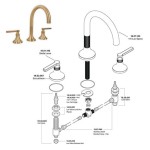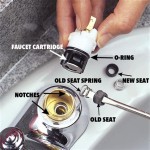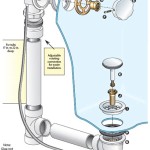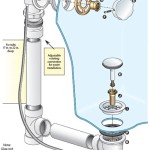Bathtub Drain Hole Size Chart: A Comprehensive Guide
Selecting the correct drain for a bathtub is a seemingly simple task, but ensuring a proper fit requires understanding the standard sizes and variations that exist. The primary component of a bathtub drain installation is determining the drain hole size, as this dictates the type and dimensions of the drain assembly that will be compatible. Mismatched sizes can lead to leaks, improper drainage, and costly rework. This article provides a comprehensive guide to bathtub drain hole sizes, covering standard measurements, how to identify the correct size, and considerations for different bathtub materials and drain types.
Understanding Standard Bathtub Drain Hole Sizes
The majority of bathtubs adhere to a set of standard drain hole sizes. This standardization simplifies the selection process and allows for interchangeability between different drain manufacturers. However, it is crucial to confirm the specific size before purchasing any drain components.
The most common bathtub drain hole size is 1 1/2 inches (1.5 inches) in diameter. This size is prevalent in standard North American bathtubs, including those made from acrylic, fiberglass, and cast iron. The 1 1/2-inch drain hole is typically threaded, allowing for the installation of a corresponding drain flange or strainer body.
While 1 1/2 inches is the most frequent size, some older bathtubs or those manufactured outside of North America may utilize a 1 3/8 inch (1.375 inches) drain hole. This slightly smaller size requires a specific drain assembly that is designed to accommodate the reduced diameter. Attempting to install a 1 1/2-inch drain in a 1 3/8-inch hole will result in an improper fit and leakage.
Apart from these standard sizes, there may be instances where custom or non-standard drain hole sizes are encountered. These are less common and typically occur in antique or custom-built bathtubs. In such cases, precise measurements are essential to ensure compatibility with the drain assembly.
In addition to the diameter of the drain hole, the thread type is a crucial consideration. Most bathtub drains utilize a standard National Pipe Thread (NPT) which is tapered. This taper creates a tight seal when the drain flange is threaded into the drain hole. However, variations in thread pitch and depth can exist, particularly in older bathtubs. Always confirm the thread compatibility before installation to prevent cross-threading or an inadequate seal.
Identifying the Correct Bathtub Drain Hole Size
Determining the correct bathtub drain hole size is a relatively straightforward process, but it requires careful measurement using appropriate tools. The most accurate method involves using a caliper, either digital or dial, to measure the inside diameter of the drain hole. This measurement should be taken at multiple points within the hole to ensure that it is uniform and to account for any irregularities or wear.
If a caliper is not available, a reliable ruler or measuring tape can be used, but the accuracy may be slightly reduced. When using a ruler or tape measure, it is essential to measure the diameter across the center of the drain hole. Avoid measuring at an angle as this will result in an inaccurate reading. If possible, remove the existing drain flange or strainer body before taking the measurement to provide a clear and unobstructed view of the drain hole.
Another method for identifying the drain hole size is to examine the existing drain assembly. If the drain assembly is original to the bathtub, the size may be stamped or engraved on the drain flange or strainer body. Look for markings indicating 1 1/2 inches or 1 3/8 inches. However, it is important to note that the existing drain assembly may not be original, so this method should be used with caution.
When replacing an existing drain, taking the old drain assembly to a plumbing supply store can be helpful. The staff can often identify the size and thread type based on the physical dimensions of the assembly. This is particularly useful if the drain assembly is corroded or damaged and the size markings are no longer legible.
Regardless of the method used, it is always recommended to double-check the measurement before purchasing any drain components. This simple step can prevent costly errors and ensure a successful installation.
Considerations for Different Bathtub Materials and Drain Types
The material of the bathtub and the type of drain being installed can influence the selection of the appropriate drain assembly. Different materials may have varying tolerances and require specific sealing techniques. Similarly, different drain types may have different flange or strainer body designs that necessitate specific drain hole dimensions.
Acrylic and fiberglass bathtubs are relatively forgiving in terms of drain hole tolerances. These materials are typically molded with precise dimensions, and the drain holes are generally consistent in size. However, it is still important to verify the drain hole size before installation. When installing a drain in an acrylic or fiberglass bathtub, use plumbers putty or silicone sealant to create a watertight seal between the drain flange and the bathtub surface. Avoid over-tightening the drain flange as this can crack or damage the bathtub material.
Cast iron bathtubs are more rigid and durable than acrylic or fiberglass bathtubs. The drain holes in cast iron bathtubs are typically threaded to a high degree of precision. However, cast iron is susceptible to corrosion, so it is important to inspect the drain hole for any signs of rust or damage. If corrosion is present, clean the drain hole thoroughly with a wire brush before installing the drain assembly. Use pipe dope or Teflon tape on the drain threads to create a watertight seal and prevent further corrosion. Because of the rigidity of cast iron, ensure proper alignment of the drain assembly during installation to prevent cross-threading.
Different drain types, such as pop-up drains, lift-and-turn drains, and toe-tap drains, have specific flange or strainer body designs that may necessitate different drain hole dimensions. For example, a pop-up drain typically has a larger flange than a standard lift-and-turn drain. Therefore, it is important to select a drain assembly that is specifically designed for the type of drain being installed. Always refer to the manufacturer's instructions for specific drain hole size requirements and installation procedures.
Waste and overflow (W&O) drain assemblies are more complex than standard bathtub drains. These assemblies include a drain fitting at the bottom of the bathtub and an overflow fitting near the top of the bathtub. The overflow fitting is designed to prevent the bathtub from overflowing. When installing a W&O drain assembly, it is important to ensure that the drain hole size is compatible with both the drain fitting and the overflow fitting. The manufacturer's instructions will specify the required drain hole size and the proper installation procedure. It is generally advisable to purchase a complete W&O drain assembly from a reputable manufacturer to ensure compatibility between all components.
In addition to the drain hole size and thread type, the length of the drain assembly is also an important consideration. The drain assembly must be long enough to reach from the bottom of the bathtub to the drain pipe in the floor or wall. If the drain assembly is too short, it will not be able to connect to the drain pipe. If the drain assembly is too long, it may interfere with the bathtub support structure. Measure the distance from the bottom of the bathtub to the drain pipe before purchasing a drain assembly to ensure that it is the correct length.
When working with plumbing connections, always adhere to local plumbing codes and regulations. These codes may specify the type of materials that can be used for drain assemblies, the required sealing techniques, and the proper installation procedures. Contacting a qualified plumber can ensure that the installation is performed correctly and in compliance with all applicable codes.

Plumbing Do Tub Drains Of The Same Diameter Ever Have Diffe Thread Per Inch Counts Home Improvement Stack Exchange

How To Size A Tub Drain

Bathtub Parts Everyone Should Know About Part Names 2024

Keeney 1 2 In Polished Chrome White Roller Ball Drain With Plastic Pipe The Bathtub Drains Department At Com

Easiest Fastest Way To Move Bathtub Drain By 3 Inches Doityourself Com Community Forums

Bathtub Drain Location Right Left Or Center Hunker

How To Replace A Bathtub Drain

Keeney 1 2 In Oil Rubbed Broe Foot Lok Stop White Lock Drain With Pvc Pipe The Bathtub Drains Department At Com

What Is Standard Size Hole For A Kitchen Or Bathroom Faucet

How To Choose A Bathtub Drain Kit Bathtubber
Related Posts








